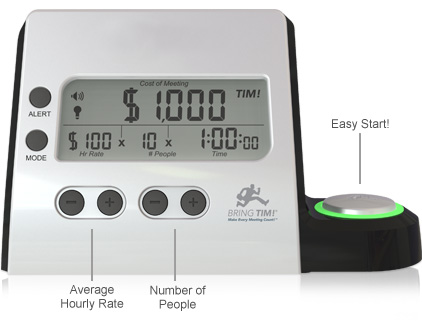If your company is anything like mine, you probably spend too much time in meetings. And you may even have meetings about how to be more efficient in meetings, and more meetings to emphasize how we are scheduling too many meetings.
It sounds surreal to me when I write it out like that, but it’s true, and it’s probably happening to you, too. Excess meetings aren’t just a waste of money and time; they have long-term impacts on the psyche as well. Luong & Rogelberg 20051 found that meetings are generally perceived as a “hassle or interruption” and there was a strong correlation between levels of tiredness, perceived workload and the number of meetings attended.
Meeting Timers/Calculators
While it’s harder to quantify perceived workload, frustration, and tiredness, it’s very simple to quantify the time and money spent in meetings – which in turn makes it much easier to take a hard look at every meeting and figure out if they really need to be that long, and if all of the people in the room really need to be there.
Meeting timers are a great way to visualize that in a way that’s incredibly clear and can be compared over time so you can monitor your team’s progress as you try to pare down your meeting times and invitee list.
A good meeting timer will let you define the cost of a resource (room, equipment, and most importantly, people) and then start a timer that shows a running calculation of how much the meeting is costing the company.
For iOS, there are several free apps you can download that do just that. These are the two I found that I thought were the best of the lot:
[starlist]- While We Were Meeting – lovely UI. Also shows neat world events that happened within the time the meeting took, which adds a neat perspective. I don’t see a way to save resources and selectively add them though, which is a bit of a drag. Hoping they update this app to add this – if they do, it will be my go-to for this.
- Meeting Ticker Lite – the interface isn’t as sexy as While We Were Meeting, but it’s perfectly fine, and it does support role-based resource costs (execs, etc) and selective number of employees.
If you prefer an online clock+calculator, check out the Meeting Ticker from Toby Tripp (fork it on Github here).
We have large-screen TVs in our main conference rooms. Imagine the impact one of these clock+calculators looming overhead could when I throw that up on the big screen via my iPad!
There’s also a snazzy inexpensive meatspace version of the meeting clock calculator called Bring TIM, which could work for officers that don’t have the luxury of a large monitor in meeting rooms, or where meetings are frequently held out of office.
Visual Patterns
There’s also a great little iOS app called Calendar Statistics, which hooks into your existing calendars and generates graphs based on the frequency, duration and number of attendees in your calendar. It can be a real eye-opener.
This app isn’t free, but the $3.99 is probably worth it if you need a tool to illustrate exactly how much of your work time is spent in meetings.
Additional Thoughts
At my company, we’re working on implementing a few policies which should hopefully help:
[checklist]- No meeting invite is to be sent out without an agenda outlined in the invite itself that details each attendee, their specific role in the meeting and any deliverables that are expected from the meeting
- Meetings should be scheduled to end 5-10 minutes earlier, to allow staff to quickly check email and regroup between consecutive meetings.
What are you doing to make meetings more efficient where you work?
